Regents Physics - Magnetism

“Magnetism, as you recall from physics class, is a powerful force that causes certain items to be attracted to refrigerators.” -- Dave Barry
Magnetism is closely related to electricity... in essence, magnetism is a force caused by moving charges. In the case of permanent magnets, the moving charges are the orbits of electrons spinning around nuceli. In very basic terms, strong permanent magnets have many atoms with electrons spinning in the same direction. Non-magnets have more random arrangements of electron spin around the nucleus. For electro-magnets, the current itself provides the moving charges. In all cases, magnetic fields can be used to describe the forces due to magnets.
Magnetic Fields
Magnets are polarized, meaning every magnet has two opposite ends. We call the end of a magnet that points toward the geographic north pole of the Earth the north pole of the magnet, while the opposite end, for obvious reasons, is called the magnet's south pole. Every magnet has both a north and a south pole. There are no single isolated magnetic poles, or monopoles. If you split a magnet in half, each half of the original magnet then exhibits both a north and a south pole, giving you two magnets. Physicists continue to search both physically and theoretically, but to date, no one has ever observed a north pole without a south pole, or a south pole without a north pole.
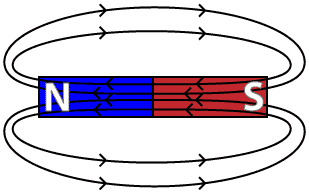
We used electric field lines to help visualize what would happen to a positive charge placed in an electric field. In order to visualize a magnetic field, we can draw magnetic field lines (also known as magnetic flux lines) which show the direction the north pole of a magnet would tend to point if placed in the field. Magnetic field lines are drawn as closed loops, starting from the north pole of a magnet and continuing to the south pole of a magnet. Inside the magnet itself, the field lines run from the south pole to the north pole. The magnetic field is strongest in areas of greatest density of magnetic field lines, or areas of the greatest magnetic flux density.

Question: The diagram at right shows the lines of magnetic force between two north magnetic poles. At which point is the magnetic field strength greatest?
Answer: Magnetic field strength is greatest in areas of the densest lines, therefore the correct answer is B.
Let's try one more example.
Question: The diagram below represents a 0.5-kilogram bar magnet and a 0.7-kilogram bar magnet with a distance of 0.2 meter between their centers. Which statement best describes the forces between the bar magnets?
(1) Gravitational force and magnetic force are both repulsive.
(2) Gravitational force is repulsive and magnetic force is attractive.
(3) Gravitational force is attractive and magnetic force is repulsive.
(4) Gravitational force and magnetic force are both attractive.Answer: Since the gravitational force is always attractive, we can rule out answers (1) and (2). Since like poles repel, the magnetic force is repulsive, therefore the correct answer is (3).
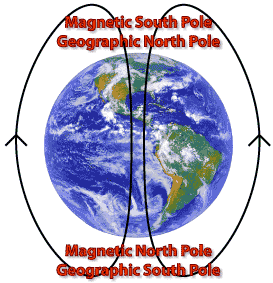
The Compass
Much like electrical charges, like poles exert a repelling force on each other, while opposite poles exert an attractive force on each other. Because the Earth exerts a force on magnets (which, when used to tell direction, we call a compass), we can conclude that the Earth is a giant magnet. If the north pole of a magnet is attracted to the geographic north pole of the Earth, and opposite poles attract, then it stands to reason that the geographic north pole of the Earth is actually a magnetic south pole! Compasses always line up with the net magnetic field.
In truth, the magnetic north and south pole of the Earth are constantly moving. The current rate of change of the magnetic north pole is thought to be more than 20 kilometers per year, and it is believed that the magnetic north pole has shifted more than 1000 kilometers since it was first reached by explorer Sir John Ross in 1831!
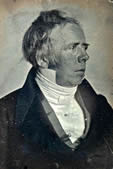
Electromagnetism
In 1820, Danish physicist Hans Christian Oersted found that a current running through a wire created a magnetic field, kicking off the modern study of electromagnetism.
Moving electric charges create magnetic fields. You can test this by placing a compass near a current-carrying wire. The compass will line up with the induced magnetic field.
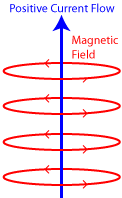
To determine the direction of the electrically-induced magnetic field, use the "right-hand-rule" by pointing your right-hand thumb in the direction of positive current flow. The curve of your fingers then shows the direction of the magnetic field around the wire.
Not only do moving charges create magnetic fields, but relative motion between a conductor and a magnetic field can produce a potential difference in the conductor. The conductor must cut across the magnetic field lines to produce a potential difference, and larger potential differences are created when the conductor cuts across stronger magnetic fields, or moves more quickly through the magnetic field.
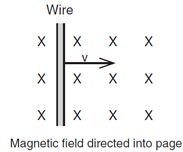
Question: The diagram at right shows a wire moving to the right at speed v through a uniform magnetic field that is directed into the page. As the speed of the wire is increased, the induced potential difference will:
- decrease
- increase
- remain the same
Answer: The induced potential difference will (2) increase as the speed of the wire is increased.
This phenomenon is what allows us to create usable, controllable electrical energy. Kinetic energy in the form of wind, water, steam, etc. is to spin a coil of wire through a magnetic field, inducing a potential difference, which is transferred by the electric company to end users. This basic energy transformation is the underlying principle behind hydroelectric, nuclear, fossil fuel, and wind-powered electrical generators!



